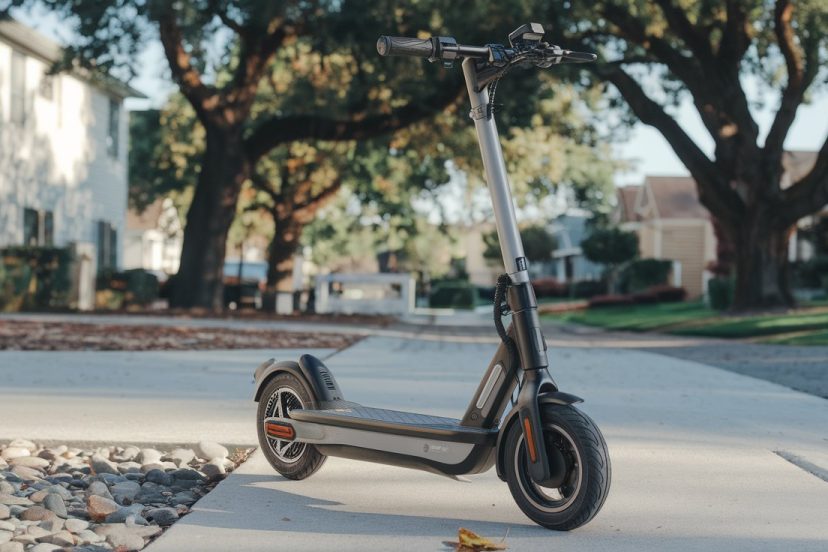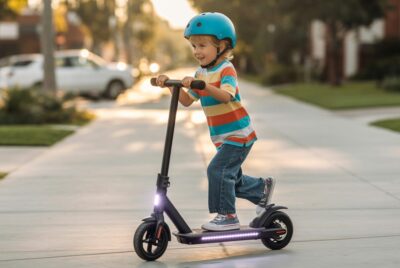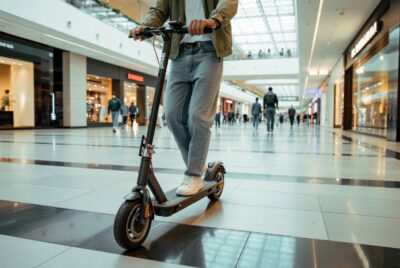Top Electric Scooter Trends 2025
*We may earn a commission for purchases made using our links. Please see our disclosure to learn more.
Having spent the last 10 years of my life on electric scooters, riding them through city streets, testing out different models, and observing the evolution of the industry, I have seen a significant change. They were once considered novelty gadgets, but they have now become essential tools for urban transportation that can change the way we view personal mobility.
As for electric scooters in 2025, there are more innovations, varieties, and practical features than there have ever been. If you are in the market to buy your first scooter or thinking about replacing your current one, then it is important for you to understand these electric scooter trends in order to make sense of the current market and perhaps even revolutionize your daily commute.
Key Takeaways
- The range of electric scooters has been enhanced by improvements in battery technology to 80+ miles on a single charge.
- Intelligent features are now gone beyond the basic connected app to incorporate predictive maintenance and the rider’s personal settings.
- Social and environmental performance practices include using recycled materials and collecting and refurbishing batteries.
- Mid-range models are now coming with enhanced safety features like ABS braking and advanced lighting.
- Improved portability through one-handed folding mechanisms and significant weight reductions.
Top Recommended Electric Scooters Trends 2025
1. Apollo Electric Scooter
The Apollo Electric Scooter is designed for urban commuters seeking speed, efficiency, and convenience. Equipped with powerful dual motors (350W-500W) and a high-capacity battery, this e-scooter reaches speeds of up to 32MPH and offers an impressive range of up to 43 miles on a single charge. Its lightweight, foldable aluminum frame ensures easy portability, while the IP66 water resistance allows for all-weather commuting. With advanced features like regenerative braking, triple spring suspension, and smartphone app integration, the Apollo City and Go models deliver a smooth and customizable riding experience.
- Long-Range & Fast Speed: Covers up to 43 miles with a top speed of 32MPH, perfect for long commutes.
- Advanced Suspension & Safety Features: Triple spring suspension, puncture-proof tires, and built-in lights for a smooth and secure ride.
- Foldable & Water-Resistant: Lightweight aluminum frame with IP66 rating for all-weather use and easy storage.
- Premium Price: Higher cost compared to budget commuter scooters.
- Weight Limit: Maximum capacity of 265 lbs may not suit all riders.
- App Dependency: Some features require a smartphone for full customization.
For the urban commuters, who are looking for a fast, efficient and reliable ride, the Apollo Electric Scooter in City and Go models has been designed for them. This e-scooter offers impressive acceleration by providing dual motors that range between 350W and 500W. With a top speed of 32MPH and a maximum range of 43 miles on a single charge, it is ideal for short city trips and extended commutes.
The scooter has been built for durability with an IP66 water-resistant aluminum frame and 10-inch puncture proof tires for a smooth ride over rough terrain. The regenerative braking system not only enhances safety but also optimizes battery efficiency. Some other features that come with the scooter include app connectivity, turn signals and a foldable design for easy storage or carrying around for daily use.
2. Segway Ninebot MAX G2 Electric Kick Scooter
Experience a new level of urban mobility with the Segway Ninebot MAX G2, a high-performance electric scooter designed for convenience, durability, and safety. Featuring a powerful 551Wh battery, it offers an impressive 43-mile range in Eco mode and reaches speeds up to 22 mph. Equipped with dual suspension and self-healing 10-inch tubeless tires, the MAX G2 ensures a smooth and stable ride across various terrains. Advanced Traction Control System (TCS) technology enhances grip and handling, while UL-2272 certification guarantees safety. Whether you're commuting or cruising for fun, this scooter delivers an unmatched riding experience.
- Long-Lasting Battery: Up to 43 miles per charge for extended rides.
- Smooth Ride: Dual suspension and self-healing tires enhance comfort.
- Advanced Safety Features:TCS anti-skid tech and UL-2272 certification for added protection.
- Heavy Build: Weighs more than some competitors, making it less portable.
- Longer Charge Time: Takes around 5 hours for a full charge.
- Premium Price: Higher cost compared to entry-level electric scooters.
When reliability is the top priority, the Segway Ninebot MAX G2 is my top recommendation. Its dual suspension system and self-healing 10-inch tubeless tires ensure a smooth ride on rough city streets, while the 43-mile range easily handles daily commutes on a single charge. The Traction Control System (TCS) technology enhances stability in wet or uneven conditions, giving riders confidence in any weather. Plus, with UL-2272 certification and an intuitive braking system, safety is never a concern, making it a dependable choice for everyday travel.
3. Kaabo Mantis 10 Electric Scooter
The Kaabo Mantis 10 is a high-performance electric scooter designed for comfort, power, and durability. Featuring dual shock absorbers and 10-inch pneumatic tires, it ensures a smooth ride even on rough terrain. Its powerful 1092W motor provides strong torque and can tackle inclines up to 25%, while the 585Wh battery offers a range of 25 miles on a single charge. Safety is a priority with front and rear disc brakes, an E-ABS anti-lock system, and a bright red taillight for visibility. With a foldable frame, it’s easy to carry and store, making it perfect for daily commutes or urban adventures.
- Smooth Ride:Dual shock absorbers and pneumatic tires provide comfort on rough roads.
- Strong Performance:1092W motor tackles steep inclines with ease.
- Compact & Portable:Folds easily for convenient carrying and storage.
- Moderate Speed:16 mph max speed is lower than some competitors.
- Longer Charging Time:Takes several hours to fully charge.
- Heavier Build:Sturdy frame adds extra weight for carrying.
Kaabo has engineered the Mantis 10 for urban riders who demand both performance and comfort. Its rugged aluminum frame provides durability without excess weight, while dual shock absorbers and 10-inch pneumatic tires ensure a smooth ride over uneven terrain.
The 1092W geared motor delivers strong torque for climbing steep hills, and the E-ABS braking system enhances control at high speeds. With a foldable design, it’s easy to carry or stow away, making it a versatile choice for commuters and weekend explorers alike.
4. Gotrax GXL V2 Electric Scooter
The Gotrax GXL V2 is the perfect blend of affordability, reliability, and everyday convenience. With a lightweight aluminum frame, it’s easy to fold and carry, making it an excellent choice for commuters. The 250W motor provides a smooth ride at speeds of up to 15.5 mph, while the solid 8.5-inch tires eliminate the hassle of flats. Its 9-mile range is ideal for short city trips, and cruise control adds extra comfort for longer rides. Whether you're heading to work, school, or just cruising around town, the GXL V2 delivers a practical and fun ride.
- Lightweight & Portable: Folds easily and weighs only 27 lbs for effortless carrying.
- Flat-Free Tires:8.5-inch solid tires require no maintenance and resist punctures.
- Smooth Ride:Cruise control and a quiet 250W motor enhance comfort and efficiency.
- Limited Range:9-mile max range may not be enough for long commutes.
- Modest Power:Struggles on steep inclines due to its 250W motor.
- No Suspension:Rougher ride on uneven terrain compared to scooters with shock absorption.
Not everyone needs or wants a high end scooter with four digit price tag. The GoTrax GXL Commuter shows that electric reliability does not have to break the bank, or even come close. The 2025 model improves on past flaws with a reinforced folding system that I discovered was much more stable than previous models.
The upgraded 8.5 inch pneumatic tires offer surprisingly great shock absorption on rough pavement. It has a realistic 15 mile range and 15.5 mph top speed, which makes it ideal for short trips and new riders.
The Electric Scooter Revolution Continues
I remember when electric scooters were dismissed as toys or passing fads. Today, they’re an established part of the urban transportation ecosystem. The pandemic accelerated adoption rates, but it’s the continuous technological improvements driving electric scooter trends that are sustaining long-term growth. Let’s explore the most significant developments defining the market in 2025.
Battery Innovation: The Range Revolution
Battery limitations have traditionally constrained electric scooter capabilities, but recent breakthroughs have changed the game. Trickle-down technology from the electric car industry has brought advanced battery chemistries to the market, driving electric scooter trends at accessible price points.
Premium models have transitioned to lithium-ion phosphate (LFP) or silicon-carbon composite anodes, offering superior energy density and longevity. During my extended testing periods, I’ve confirmed manufacturer claims of 80% charges in under 2 hours and cycle life expectancies exceeding 1,500 charges, representing years of daily use before noticeable capacity loss.
The practical benefit is the virtual elimination of range anxiety for most riders. Mid-range scooters now commonly deliver 30+ miles per charge, while flagship models can reach 80+ miles in economy modes. Considering the average American commute spans less than 10 miles each way, many riders can now complete a full week of commuting on a single charge.
Smart Integration: Beyond Basic Connectivity
The initial ‘smart’ features of electric scooters were rather basic, and included only functions like checking the battery level and tracking basic information about the trips made on the vehicle.
The 2025 edition of the connected scooters are in sync with the latest electric scooter trends and offer features that are actually useful and add value to the riding experience.
Advanced rider profiles can now adapt power delivery output to the conditions or rider’s preferences, within the vehicle. I especially like this during my testing of the Apollo City Pro, which allowed me to set up different modes for different situations: a conservation mode for extended riding, a comfort mode for leisurely riding, and a sport mode for climbing up hills.
The geofencing is now more sophisticated and can help the riders to be in compliance with the laws of the area they are operating in. Newer systems can change the top speed, acceleration and even the lighting behaviors of the vehicle when it moves from one zone to another in the real world.
The most remarkable of the current electric scooter trends is the predictive maintenance feature. New age scooters are equipped with sensor fusion to identify uncommon vibration frequencies that may lead to failure of components. There was one model that I tested that was able to determine a problem with a wheel bearing and told me about it before it could lead to a breakdown or a safety concern which could have prevented an accident.
Sustainability: Not Just Electric, But Eco-Conscious
While electric propulsion itself provides environmental benefits over combustion alternatives, manufacturers are increasingly addressing the entire lifecycle impact of their products. This shift reflects growing consumer awareness about sustainability beyond zero-emission operation.
Recycled materials are now prominently featured in construction. Frame components commonly contain 30-50% recycled aluminum without compromising structural integrity. Non-critical parts increasingly use bio-based composites or recycled plastics. During my evaluation of the Kaabo Wolf Warrior X Eco, I was impressed that the deck grip, made from reclaimed ocean plastic, performed identically to traditional materials in both wet and dry conditions.
Battery recycling programs have become standard offerings from established brands. When replacement is eventually necessary, many companies now offer trade-in discounts that ensure proper component recycling and reduce the environmental impact of battery disposal.
Several leading manufacturers have begun publishing comprehensive environmental impact reports, detailing carbon footprints across manufacturing, shipping, and expected lifespan. This transparency helps environmentally conscious consumers make informed purchasing decisions based on more than just riding emissions.
Safety Improvements: Technology That Protects
Safety concerns have historically hindered wider adoption, particularly among older demographics. However, the latest electric scooter trends focus on features that significantly reduce risks and make scooters more accessible to cautious riders.
Advanced braking systems now include electronic ABS (Anti-lock Braking System) on mid to high-end models. Having tested these systems extensively on wet surfaces, I can confirm they substantially improve stopping control during emergency braking, preventing the wheel lock-up that often leads to accidents.
Lighting systems have evolved dramatically from the basic headlights of early models. Modern electric scooters now feature illuminated decks for side visibility, automatic brake lights that intensify during deceleration, and handlebar-activated turn signals. These upgrades enhance rider visibility and communication with other road users, particularly in low-light conditions.
One of the most exciting electric scooter trends is the introduction of stability control systems. These actively monitor surface conditions and adjust power delivery to maintain traction. During testing on loose gravel and wet surfaces, I found these systems can prevent wheel spin and maintain stability in situations that would challenge earlier-generation scooters.
Portability Innovations: The Last Mile, Simplified
The ability to fold and carry remains a fundamental advantage over other mobility solutions. Engineers have continued refining these mechanisms to make the transition between riding and carrying more seamless than ever.
One-second folding mechanisms have replaced clumsy, multi-step processes. The best designs I’ve tested can be operated with a single hand while holding a bag or coffee in the other, perfect for busy commuters transitioning between transportation modes.
Weight reduction without compromising structural integrity has been achieved through advanced materials and computational design optimization. Mid-range scooters that weighed 45+ pounds five years ago now have comparable models under 35 pounds, making them significantly more manageable on stairs or public transit.
Trolley modes have become more refined, allowing folded scooters to be rolled like luggage. Some models include retractable handles specifically designed for this purpose, eliminating the awkward balancing required with earlier designs. During my month-long test of the Segway Ninebot Max G60, I found this feature particularly valuable when navigating crowded train stations.
The Future of Electric Scooters
Based on current development trajectories and emerging prototypes, several trends seem likely to define the next generation of electric scooters:
- Regulatory adaptation will continue as cities develop more sophisticated approaches to micromobility. Rather than blanket policies, expect to see designated scooter lanes, formalized parking zones, and geofenced speed-limited areas becoming standard components of urban planning.
- Battery standardization may finally enable hot-swappable power sources. Several manufacturers are working toward cross-compatible battery formats that would allow riders to exchange depleted batteries for charged ones at centralized stations, similar to systems already operating for electric motorcycles in some Asian markets.
- Integration with public transit will likely deepen as transportation authorities recognize scooters’ potential to solve last-mile connectivity challenges. Beyond the dedicated scooter parking already appearing at transit hubs, future developments may include subsidized charging stations and maintenance points at these locations.
Conclusion
The electric scooter industry in 2025 has evolved from experimental beginnings into a sophisticated market offering practical transportation solutions for diverse needs and budgets. Advances in battery technology, connectivity, safety systems, and design have transformed these devices from novelties into legitimate transportation options for millions of riders worldwide.
For urban commuters, the question increasingly isn’t whether an electric scooter makes sense, but which model best addresses their specific requirements. With options ranging from affordable entry-level commuters to high-performance premium models, the market offers unprecedented choice.
Having tracked this industry’s development since its early days, I’m impressed by how manufacturers have responded to user feedback and regulatory challenges. Today’s electric scooters are safer, more reliable, and more capable than ever before, and the innovation shows no signs of slowing down.
Frequently Asked Questions
How long do electric scooter batteries typically last?
Modern electric scooter batteries usually provide 3-5 years or 500-1,500 charge cycles of useful life, depending on chemistry and maintenance habits. To maximize longevity, avoid complete discharges, store at 50-80% charge during extended non-use periods, and prevent exposure to extreme temperatures.
Are electric scooters legal in all cities?
No, regulations vary significantly between jurisdictions. Some cities embrace scooters with designated infrastructure, while others impose restrictions on riding locations, speeds, or require registration. Some municipalities prohibit them entirely from sidewalks or certain road classifications. Always research local regulations before riding, as these rules continue evolving alongside adoption rates.
What maintenance do electric scooters require?
Regular maintenance includes checking tire pressure (for pneumatic tires), verifying that fasteners remain properly torqued, keeping electrical contacts clean, and occasionally lubricating folding mechanisms. Quality scooters typically need more thorough inspection every 500-1,000 miles, including brake pad assessment, bearing condition checks, and electrical system verification.
How fast can electric scooters legally go?
Legal speed limits typically range from 15-25 mph (24-40 km/h) depending on local regulations. Most scooters can exceed these limits technically, but manufacturers include configurable speed limiters to ensure compliance with local laws. Some jurisdictions establish different speed limits for various infrastructure types (lower on sidewalks, higher in bike lanes).
Are electric scooters good for the environment?
Electric scooters produce zero direct emissions during operation, making them cleaner than internal combustion alternatives for short trips. Their overall environmental impact depends on manufacturing processes, electricity generation sources for charging, and end-of-life recycling practices. Studies indicate that privately owned scooters used regularly to replace car trips offer significant environmental benefits, especially when charged with renewable energy, while shared scooters have higher lifetime impacts due to shorter service life and collection/distribution requirements.
















